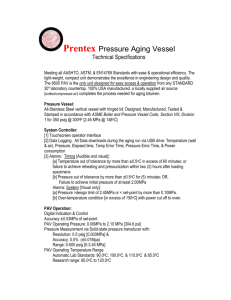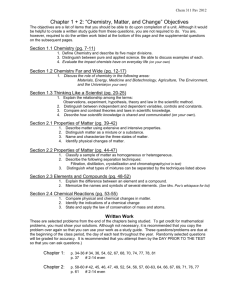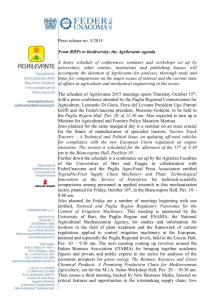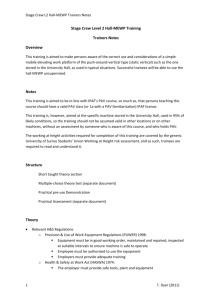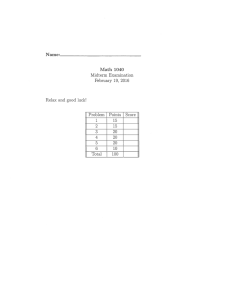Characterization of the viscoelastic behavior of complex
advertisement
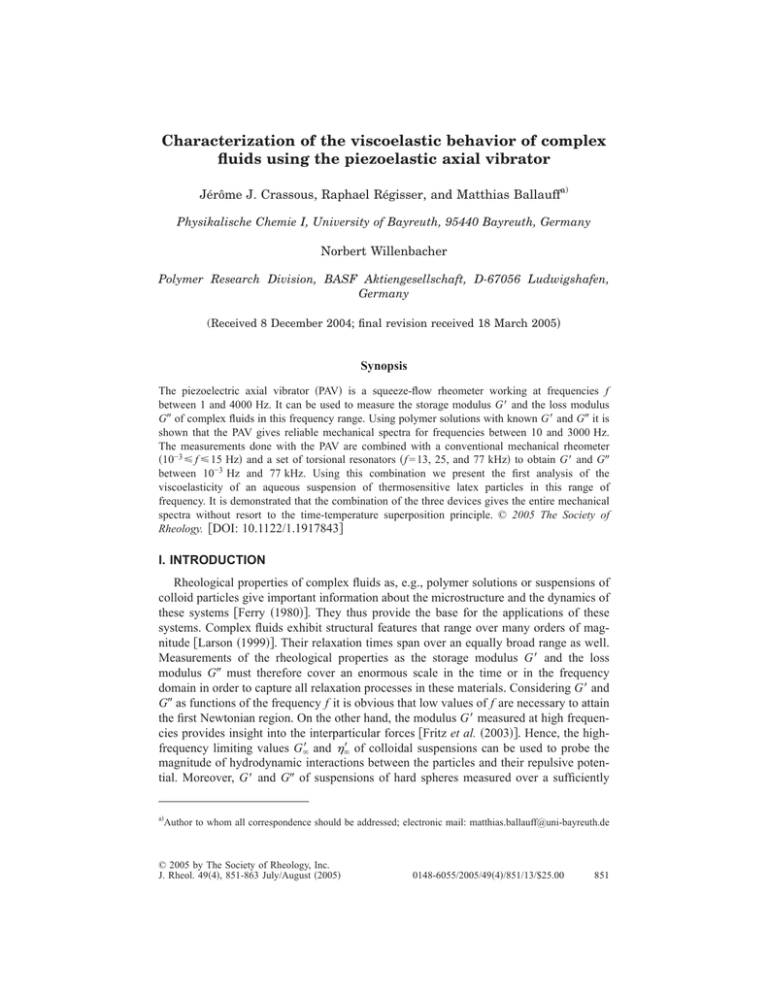
Characterization of the viscoelastic behavior of complex fluids using the piezoelastic axial vibrator Jérôme J. Crassous, Raphael Régisser, and Matthias Ballauffa) Physikalische Chemie I, University of Bayreuth, 95440 Bayreuth, Germany Norbert Willenbacher Polymer Research Division, BASF Aktiengesellschaft, D-67056 Ludwigshafen, Germany (Received 8 December 2004; final revision received 18 March 2005兲 Synopsis The piezoelectric axial vibrator 共PAV兲 is a squeeze-flow rheometer working at frequencies f between 1 and 4000 Hz. It can be used to measure the storage modulus G⬘ and the loss modulus G⬙ of complex fluids in this frequency range. Using polymer solutions with known G⬘ and G⬙ it is shown that the PAV gives reliable mechanical spectra for frequencies between 10 and 3000 Hz. The measurements done with the PAV are combined with a conventional mechanical rheometer 共10−3 艋 f 艋 15 Hz兲 and a set of torsional resonators 共f = 13, 25, and 77 kHz兲 to obtain G⬘ and G⬙ between 10−3 Hz and 77 kHz. Using this combination we present the first analysis of the viscoelasticity of an aqueous suspension of thermosensitive latex particles in this range of frequency. It is demonstrated that the combination of the three devices gives the entire mechanical spectra without resort to the time-temperature superposition principle. © 2005 The Society of Rheology. 关DOI: 10.1122/1.1917843兴 I. INTRODUCTION Rheological properties of complex fluids as, e.g., polymer solutions or suspensions of colloid particles give important information about the microstructure and the dynamics of these systems 关Ferry 共1980兲兴. They thus provide the base for the applications of these systems. Complex fluids exhibit structural features that range over many orders of magnitude 关Larson 共1999兲兴. Their relaxation times span over an equally broad range as well. Measurements of the rheological properties as the storage modulus G⬘ and the loss modulus G⬙ must therefore cover an enormous scale in the time or in the frequency domain in order to capture all relaxation processes in these materials. Considering G⬘ and G⬙ as functions of the frequency f it is obvious that low values of f are necessary to attain the first Newtonian region. On the other hand, the modulus G⬘ measured at high frequencies provides insight into the interparticular forces 关Fritz et al. 共2003兲兴. Hence, the highfrequency limiting values G⬁⬘ and ⬁⬘ of colloidal suspensions can be used to probe the magnitude of hydrodynamic interactions between the particles and their repulsive potential. Moreover, G⬘ and G⬙ of suspensions of hard spheres measured over a sufficiently a兲 Author to whom all correspondence should be addressed; electronic mail: matthias.ballauff@uni-bayreuth.de © 2005 by The Society of Rheology, Inc. J. Rheol. 49共4兲, 851-863 July/August 共2005兲 0148-6055/2005/49共4兲/851/13/$25.00 851 852 CRASSOUS et al. wide range of frequencies may be evaluated to yield information about the structural arrest of the spheres at high volume fractions 关Mason and Weitz 共1995a; 1995b兲兴 that can be related to the theory of the glass transition 关Goetze and Sjoegren 共1991兲兴 in these systems. This brief introduction demonstrates that techniques capable of measuring viscoelasticity of complex fluids over a wide range of frequencies are needed 关Fritz et al. 共2003兲; Sohn and Rajagopalan 共2004兲兴. Conventional mechanical rheometers, however, can only access the range of low frequencies 共⬍50 Hz兲 because of the inertial effects. Mellema and co-workers have introduced the use of torsional resonators for the study of colloidal suspensions 关van der Werff et al. 共1989兲兴. More recent developments in this field have been summarized by Romoscanu et al. 共2003兲. In particular, Willenbacher and co-workers demonstrated that torsional resonators can be used for measurements at high frequencies in the kilohertz range 关Fritz et al. 共2003兲兴. The obvious disadvantage of torsional resonators is the fact that these devices can be used only at given frequencies. Intermediate frequencies have often been accessed by use of the time-temperature superposition principle 关Ferry 共1980兲兴. An example for this approach in the field of suspension rheology is the work of Shikata and Pearson 共1994兲 on hard sphere colloids. But in general, the time-temperature superposition principle is not applicable for complex fluids. Therefore measurement techniques that span the entire frequency range without resorting to the time-temperature superposition principle are of central interest in the field of complex fluids. Microrheological techniques recently introduced by Mason and Weitz 共1995a; 1995b兲; Mason et al. 共1996兲, 关Mason 共1999兲兴 give access to a wide range of frequencies. Moreover, the mechanical spectra are derived for a continuous range of frequencies. Microrheology, however, relies on the so-called “generalized Stokes–Einstein relation” which may hold only for certain systems. It has been shown to be inadequate for charged colloids 关Koenderink et al. 共2003兲兴, and its applicability to complex fluids must be checked in each case. Finally, for the intermediate frequency only a few instruments were able to give a continuous and reliable measurement as, e.g., the piezorheometer described in the work of Cagnon and Durand 共1980兲 or the piezoelectric rotary vibrator 关Kirschenmann 共2002兲兴 both working in shear strain. Recently, Pechhold and co-workers introduced a new device named “piezoelectric axial vibrator” 共PAV兲. It consists of a dynamic press with a thin gap in which the liquid is confined. A squeeze flow is generated by a piezoelectric drive and the answer of the system measured by piezosensors can be evaluated to lead to G⬘ and G⬙ between 10 and 4000 Hz. In this way the PAV closes the gap in the frequency range of conventional rheometers and the torsional resonators. In principle, the concept of the PAV is very appealing and the frequency range accessible by this instrument is exactly in the range that must be probed for the study of typical complex fluids. Based on earlier work by Kirschenmann 共2003兲 we present a comprehensive test of the PAV as applied to typical complex fluids as polymer solutions and colloidal suspensions. We compare the results obtained with this instrument to data from conventional rotational rheometry at low frequencies and from a set of torsional resonators at high frequencies. Moreover, the data obtained from rotational rheometry at various temperatures are shifted according to the time temperature superposition principle in order to cover the same frequency range as the PAV. The purpose of this paper is twofold: 共i兲 At first we examine the reliability of the PAV and its possible limitations and 共ii兲 we demonstrate that the combination of the three rheometers, namely the mechanical spectrometer, the PAV, and the torsional resonators provide a convenient and reliable access to the viscoelastic properties of complex fluids PIEZOELASTIC AXIAL VIBRATOR 853 FIG. 1. Mechanical equivalent model of the PAV. The material with the complex stiffness K* is enclosed in the gap 共shaded area兲 of radius R and thickness d. The lower plate oscillates with a given frequency with constant force amplitude F̂. The dynamic displacement of the lower plate leads to K* and in turn to the complex modulus G*. See text for further explanation. over 5–7 orders of magnitude in frequency. This will be further demonstrated by analyzing the viscoelasticity of a suspension of thermosensitive particles. II. THEORY The general theory of squeeze flow is well exposed in standard textbooks of rheology 关Bird et al. 共1987兲兴 and the theory of the PAV has been already presented in the work of Kirschenmann 共2003兲. Here it suffices to delineate the main features. Figure 1 gives a scheme of the PAV. The lower plate oscillates with constant force amplitude F̂. When the PAV is unloaded, the dynamic displacement x̂0 of the lower plate is measured at a given frequency leading to the compliance x̂0 / F̂. The same measurement is repeated at the same frequencies with the material under consideration filling the gap 共see Fig. 1兲. This gives the modulated compliance x̂ / F̂. From the complex ratio x̂0 / x̂, the complex squeeze stiffness K* of the material can be calculated by use of an appropriate mechanical equivalent circuit 共see Fig. 1兲 and solving its equations of motion 共1兲 关Kirschenmann 共2003兲兴: 冦 − 2m1x1 = − K*共x1 − x0兲 − K1x1 − 2m0x0 = − K*共x0 − x1兲 − K01共x0 − x2兲 + F 0 = − K01共x2 − x0兲 − K02x2 − F. For linear viscoelasticity this calculation leads to the formula K* = 冉 冊 冒冉 3 R R 2 d 3 G* 1+ 冊 2d2 + ... , 10G* 冧 共1兲 共2兲 where R is the radius of the plate, d Ⰶ R is the gap width, is the density of the squeezed material, and G* is its complex shear modulus. The expression of the numerator agrees with that derived in the literature 关Bird et al. 共1987兲兴, 关Laun et al. 共1999兲兴. The denominator contains the first term 共slit approximation兲 of a series expansion that takes into account the inertia of the material in the gap. This effect may become important at very high frequencies. Equation 共2兲 tacitly assumes an incompressible material and hence only considers the complex shear modulus G* or the complex compliance J* = 1 / G*. For precise measure- 854 CRASSOUS et al. FIG. 2. 共a兲 Piezoelectric axial vibrator used in this study. The upper lid is removed to show the plate moved by the piezodrives. 共b兲 Longitudinal cut of the PAV 共left-hand side兲 and transversal cut 共right-hand side兲 of the quadratic tube containing the actor and the sensor piezoelements. Four actor piezoelements elements are stuck on both side of two opposite tube walls. Another four sensor piezoelements elements are stuck on both of the remaining walls. Four partial cuts avoid direct coupling between actor and sensor elements. ments, however, the dynamic compressibility * must be introduced as well. For squeeze flow 共in the limit of small amplitudes兲 one obtains 关Kirschenmann 共2003兲兴: 冉 冊 1 2 d3 1 3 R2 * = + . K* 3 R4 G* 2 d2 共3兲 Equation 共3兲 demonstrates that the correction due to a finite compressibility depends strongly on the ratio R / d. Its magnitude can be obtained through performing measurements at different gap thickness d. III. EXPERIMENT A. Instruments The PAV is a dynamic press working at frequencies between 1 and 4000 Hz. The actor/sensor is a thin-walled quadratic copper tube carrying on top a thick stainless steel plate, which serves as the lower boundary of the sample gap 共see Fig. 2兲. As shown in PIEZOELASTIC AXIAL VIBRATOR 855 TABLE I. Viscosities of different glycerol/water mixtures at 20 ° C 关D’ Ans and Lax 共1967兲兴 used for the calibration of the PAV. Weight fraction of glycerol at 20 ° C 共mPa s兲 0 35 50 65 75 85 95 100 1.005 3.040 6.050 15.54 36.46 112.9 545 1499 Fig. 2共b兲, four piezoelements are attached to two opposite walls of the tube in order to exert the vibrations while four additional piezos are fixed to the remaining sides in order to pickup the response signal. Direct coupling of excitation and detection is avoided by four lengthwise cuts of the tube 关see Fig. 2共b兲兴. This lower part of the device is surrounded by a double walled cylinder allowing the circulation of a thermostating fluid. The whole setup is covered by a thick metal lid, which is the upper boundary of the gap and provides a complete sealing of the fluid. The rigidity K0 of the cylinder must at least attain 1.108 N m−1 to assure a high resonance frequency for the head of the probe and the sensor cylinder. Therefore the sample rigidity, K*, should be lower than 109 N m−1. The PAV is operated by a lock-in-amplifier. The exciting voltage of the driving piezos is proportional to the axial force. The measured voltage of the piezos that monitor the deformation is the signal used for determining K*. The width d of the gap of the squeezeflow rheometer is defined by the lid mounted onto the rheometer 共see Fig. 2兲. In order to vary the gap, several rings of 10, 35, 50, 100 m thickness can be used. The variation of the gap turned out to be necessary in order to perform the measurements in the correct range. Systems with low viscosities must be measured using a small d whereas higher viscosities needed a wider gap 共see later兲. Hence, variation of the gap width between 20 and 200 m covers measurements of the viscosity in the range between 1 and 2000 mPa s. The required sample volume is on the order of 100 L depending on the width of the gap. In all case the amount of liquid was accurately adjusted by a microsyringe. The temperature was controlled with an accuracy of ±0.02 ° C. B. Calibration of the instrument and accuracy The instrument was calibrated using Newtonian liquids of different viscosity to determine the optimal gap for each range of viscosities. For this purpose a set of different glycerol/water mixtures was used. The viscosities of these mixtures are summarized in Table I. In order to compare the viscosities obtained by the PAV to data from other systems, two rheometers have been employed: A rheometrics fluid spectrometer for the range of low frequencies 共0.01– 15 Hz兲, and the torsional resonators introduced recently by Willenbacher and co-workers 关Fritz et al. 共2003兲兴 for the region of high frequencies. In the following we give a brief description of the measurements using these devices. The Fluids Spectrometer RFS II from Rheometrics Scientific is a strain-controlled rotational rheometer equipped with a Couette system 共cup diameter: 34 mm, bob diameter: 32 mm, bob length: 33 mm兲. Strains are applied in the range starting from 500% for 856 CRASSOUS et al. FIG. 3. Viscosities of water-glycerin mixtures measured with fluid spectrometer RFS II 共open quadrangles兲, PAV 共filled symbols兲, and torsional resonators 共open triangles兲. The weight percent of glycerol is varied between 0% and 100% as indicated in the graph in order to adjust a wide range of viscosities. The values of Table I are indicated by the dashed lines. Different gap thickness were used for the PAV: 20, 35, 50, 100, and 200 m to obtain the optimal measurement. An experimental value of the true gap thickness was also calculated for each gap and given directly in the graph. the low viscosity liquids to provide an accurate response up to 0.5% for the more viscoelastic solutions. For each measurement the deformation was set to remain in the linear viscoelastic regime. Measurement were performed on 10 mL of the fluid and the temperature was set with an accuracy of ±0.05 ° C. Two torsional resonators supplied by the Institut für dynamische Materialprüfung, Ulm, Germany, have been used to obtain data at high frequencies 关Fritz et al. 共2003兲兴. Two geometries are available 共cylinder or double-dumbbell兲 allowing for measurements at 13, 25, and 77 kHz. The penetration depth of the shear wave is typically on the order of 50 m for the samples investigated here. This ensures that the method probes the viscoelastic properties of the bulk phase. The measuring cell, however, is much larger than this penetration depth and no disturbance may result from the walls of the container. The small amplitudes of the torsion of the cylinder 共⬇50 nm兲 ensure that the maximum strain is small. The measurements are hence taken in the linear viscoelastic regime. The experimental procedure and the evaluation of data have been described recently 关Fritz et al. 共2003兲兴. The real part of the complex viscosity of water-glycerine mixtures is plotted against the frequency in Fig. 3. Here data obtained by all the three devices are presented. The gaps of the PAV was varied 共d = 20, 35, 50, 100, and 200 m兲 in order to adjust for the viscosity of the sample ranging from 1 to 1500 mPa s 共dashed lines in Fig. 3兲. The viscosity was calculated using Eq. 共2兲 and the width d of the gap was slightly adjusted so that the experimental value was matched. This calibration of the width of the gap is used in subsequent measurements. Moreover, results obtained for one sample but different gap widths demonstrated that the contribution due to the dynamic compressibility 关cf. Eq. 共3兲兴 is negligible for these Newtonian liquids as expected. Figure 3 also delineates the optimal domains of the measurement of the PAV by dashed lines. In these domains the measured viscosity is independent of the frequency. In PIEZOELASTIC AXIAL VIBRATOR 857 FIG. 4. Validation of G⬘ 共full symbols兲 and G⬙ 共hollow symbols兲 measured with fluids spectrometer RFS II 共quadrangles兲, PAV 共circles兲, and torsional resonators 共triangles兲 obtained for a 30% polystyrene solution in ethylbenzene. The data are compared to results derived from the time temperature superposition principle. Values of G⬘ are indicated by dashed lines whereas G⬙ is given by solid lines. The data obtained by the PAV have been measured at the optimal gap thickness. the following only data from these optimal domains will be shown. The good correspondence between the three apparatus illustrates the quality of the measurements provided by the PAV for the Newtonian solutions. C. Viscoelastic fluids: Polystyrene solution We use a commercial polystyrene grade 共PS 148 H from BASF兲 dissolved in ethylbenzene as a benchmark system to check the accuracy of the measurements of G⬘ and G⬙ by the PAV. Concentrated polymer solutions present well-studied examples of viscoelastic fluids that exhibit moduli varying over many orders of magnitude with increasing frequency 关Graessley 共1974兲兴. The ethylbenzene used was of commercial grade without special purification. The solution contains 30% polystyrene with M w = 148 000 g / mol. Solutions of polystyrene were carefully studied and precise data based on the time-temperature superposition principle are available 关Graessley 共1974兲; Baumgärtel and Willenbacher 共1996兲兴. G⬘ and G⬙ of this solution as the function of frequency was obtained as follows: Rheological measurements with a mechanical rheometer were done at −80, −50, and 24 ° C. In order to obtain a wide range of frequencies, the frequency-temperature superposition principle has been used as already discussed by Baumgärtel and Willenbacher 共1996兲. The temperature dependence can be described by a universal, concentration invariant Williams–Landel–Ferry-shift parameter aT 关Williams et al. 共1955兲兴: log10 aT = − c1共T − Tref兲 . c2 + T − Tref 共4兲 We have chosen Tref = 20 ° C and obtain c1 = 1.47 and c2 = 143 K. Figure 4 displays G⬘ and G⬙ as the function of the frequency. Data at low frequency have been obtained by the mechanical spectrometer RFS II whereas the three points referring to the highest frequencies have been measured using the torsional resonators. The data at intermediate frequencies have been obtained with the PAV using the optimal 858 CRASSOUS et al. FIG. 5. Enlarged portion of Fig. 4 showing G⬘ and G⬙ measured by the PAV with different width d of the gap: 100 共䉮兲, 150 共씲兲, 185 共䉭兲, and 200 m 共䊊兲. width of the gap 共see the discussion of Fig. 3兲. The data obtained by the three widely different instruments fit together within the limits of error of the respective devices. The lines give the respective values of G⬘ 共dashed兲 and G⬙ 共full兲 derived from Eq. 共4兲. Good agreement is seen over six orders of magnitude. There are only small deviations between the measured data and the spectra calculated from the time-temperature superposition principle. We assign these small discrepancies to the limitation of Eq. 共4兲 and to the experimental uncertainties in obtaining the moduli in such a wide temperature range. Figure 5 demonstrates that the width d of the gap has a minor influence on the resulting values of G⬘ and G⬙. Here G⬘ and G⬙ obtained from the poly共styrene兲 solution by the PAV for different width of the gap are plotted against the frequency f. Evidently, G⬘ and G⬙ do not depend on d within the given limits of error. The maximum of error amounts to 20% if the width of the gap is not optimal. This further confirms the reliability of the instrument and justifies the neglect of the dynamic compressibility 关cf. Eq. 共3兲兴. Thus, the earlier discussion has established two criteria for the accuracy of the measurement: First, the optimal width of the gap is obtained by measurement of Newtonian PIEZOELASTIC AXIAL VIBRATOR 859 liquids. The small corrections for the width of the gap, which followed from this calibration demonstrates that Eq. 共2兲 provides a accurate description of the flow in the instrument. Second, the measured spectra of G⬘ and G⬙ must be independent of the width d. This is seen indeed in Fig. 5 and the residual discrepancies at low frequency can be traced back to a width of the gap which is not optimal. From these data and the foregoing comparison using a polystyrene solution as a benchmark system we conclude that the PAV gives reliable data for polymer systems that exhibit a marked viscoelastic behavior. The range of concentrations that can be studied is only limited by the smallest gap available 共see the discussion of Fig. 3兲. Hence, highly dilute polymer solutions in which the viscosity exceeds hardly the one of the solvent cannot be measured with the PAV with sufficient accuracy 关see the discussion of this problem in Stokich et al. 共1994兲兴. D. Methylcellulose in solution Aqueous solutions of methylcellulose 共MC兲 gel upon heating 关Leibler et al. 共1991兲兴. The gelation is thermoreversible and ascribed to the presence of hydrophobic interactions. The rheology of this system was already investigated in a study of Desbrières 关Desbrières et al. 共1999兲兴 and the rheological experiments were carried out on the piezorheometer built by Palierne 关Bartolino and Durand 共1977兲; Cagnon and Durand 共1980; 1981兲兴. Hence, these solutions provide another benchmark system. Methylcellulose has been purchased from Sigma-Aldrich. The weight average molecular weight of MC is 86 000 g mol−1. The degree of substitution is ranging from 1.6 to 1.9 as indicated by the manufacturer. It was purified by dialysis in order to remove salts and other low molecular weight impurities. Solutions of ⬃2 wt % of methylcellulose were prepared in de-ionized water and stirred for 2 days to ensure a homogeneous solution. This solution was then packed in Spectra/Por® dialysis tube membranes which were bought from Spectrumlabs 共MWCO-2000兲. Dialysis was carried out until the conductivity of water became equal to pure de-ionized water. Later the solution was dried in a vacuum oven at 80 ° C. The pure methylcellulose was then stored for further use. The measurements were performed on a solution of 1.5 wt % at 20 ° C. Again the range of frequencies was covered by measurement using the three instruments. The rheogram shown in Fig. 6 is typical of an entangled polymer solutions. As can be seen from Fig. 6, a good correspondence between the three instruments is seen. The residual differences between the instruments are within their respective limits of error. This demonstrates again that concentrated polymer solutions can be measured by the combination of the three instruments. Following earlier work 关Desbrières et al. 共1999兲兴 a general Maxwell’s model was used to describe the data. The expression that includes the high-frequency contribution reads * = 0 + ⬁ , 1 + 共i0兲1−h 共5兲 where 0 is the zero-shear viscosity and ⬁ denotes the high-shear viscosity. Finally, 0 is the average time of relaxation and the parameter h describes the width of the relaxation time distribution. Figure 6 demonstrates that Eq. 共5兲 provides a good description of the results over the entire range of frequencies under consideration here. This is in agreement with the earlier studies 关Desbrières et al. 共1999兲兴. 860 CRASSOUS et al. FIG. 6. Elastic 共full symbols兲 and loss 共hollow symbols兲 modulus of a 1.5 wt % methylcellulose solution at 20 ° C measured with fluids spectrometer RFS II 共quadrangles兲, PAV 共circles; measured at optimal thickness of the gap 100 m兲, and torsional resonators 共triangles兲. The fit was done using the generalized Maxwell’s model including the high frequency contribution 关Eq. 共5兲兴. The fitted parameters are: 0 = 1.4 Pa s, ⬁ = 2.5 mPa s, 0 = 0.002 s, h = 0.32. E. Thermosensitive latex particles As an example for a complex fluids we analyze here a thermosensitive latex that has been under scrutiny recently 关Senff et al. 共1999兲兴. The particles consist of a solid poly共styrene兲 core and a shell composed of crosslinked poly共N-isopropylacrylamide兲 共PNIPA兲 chains. Suspended in water these particles swell when lowering the temperature below room temperature through the uptake of water in the shell. Going to temperatures above 25– 30 ° C leads to a marked decrease of the particles radius because the water is expelled from the thermosensitive PNIPA-layer again. This swelling transition within the layer is fully reversible 关Dingenouts et al. 共1998兲; Seelenmeyer et al. 共2001兲兴 and can be used to adjust the effective volume fraction eff of the particles by increasing or lowering the temperature 关Senff et al. 共1999兲兴. Evidently, the time-temperature superposition principle cannot be applied for determining G⬘ and G⬙. The core-shell latex used in this study was prepared as described recently 关Dingenouts et al. 共1998兲; Seelenmeyer et al. 共2001兲兴. The core particles has a radius of 52.5 nm and the shell a thickness of 52.8 nm at 10 ° C as determined by light scattering. The degree of crosslinking was 2.5 mol % with regard to monomer N-isopropylacrylamide. The latex was purified by ultrafiltration. The weight concentration of the latex was 10.9 wt %. The 3 corresponding effective volume fraction eff = 共4 / 3兲RH could be determined from the hydrodynamic radius RH available from dynamic light scattering 关Seelenmeyer et al. 共2001兲兴. For the suspension under consideration here eff = 0.585 at a temperature of 10 ° C. The rheological measurements were realized with the set of the three instruments. A period of 1 h was allowed for thermal equilibrium before starting each measurement. Figure 7 displays G⬘共兲 and G⬙共兲 obtained in this way over the entire range of frequencies. As already discussed by Mason and Weitz 共1995a; 1995b兲, a suspension of hard spheres in the vicinity of the glass transition should exhibit the features seen in Fig. 7: The storage modulus G⬘ is expected to exhibit a marked plateau for a rather wide range of frequencies while G⬙ is expected to go through a pronounced minimum. PIEZOELASTIC AXIAL VIBRATOR 861 FIG. 7. Elastic 共full symbols兲 and loss 共hollow symbols兲 modulus of a concentrated thermosensitive latex 10.85% wt at 10 ° C 共eff = 0.585兲 measured with fluid spectrometer RFS II 共quadrangles兲, PAV 共circles兲, and torsional resonators 共triangles兲. The data obtained by the PAV have been measured at the optimal thickness of the gap. The experimental data are fitted by the model proposed by Mason and Weitz 关Eq. 共6兲–共8兲兴 with G P = 21 Pa, G = 0.4 Pa, t = 1 s rad−1, eff = 0.585, DS = 4.10−13 m2 s−1, and ⬁⬘ = 3 mPa s. The model proposed by Mason and Weitz 共1995a; 1995b兲 can be used for the quantitative description of the data thus obtained. It is based on the combination of three major effects. The low frequency behavior is described within mode coupling theory 关Goetze 共1999兲兴. It assumes that the stress autocorrelation function has the same functional form as the density autocorrelation function. The high-frequency the data analysis is complicated due to an anomalous contribution to both G⬘ and G⬙ proportional to 0,5 which arise from a diffusional boundary layer between the spheres 关Lionberger and Russel 共1994兲兴. The high frequency suspension viscosity ⬁⬘ leads to a contribution to G⬙ that is proportional to . It can be taken from the experimental data obtained at highest frequencies by use of the torsional resonators. The resulting expressions for G⬘ and G⬙ are 关Mason and Weitz 共1995a; 1995b兲兴: 冋 冉 冊 G⬘共兲 = G P + G ⌫共1 − a⬘兲cos 册 冉 冊 a⬘ b⬘ ⬘ 共兲 共t兲a⬘ − B⌫共1 + b⬘兲cos 共t兲−b⬘ + GD 2 2 共6兲 and 冋 冉 冊 G⬙共兲 = G ⌫共1 − a⬘兲sin 冉 冊 册 a⬘ b⬘ ⬙ 共 兲 + ⬁ , 共t兲a⬘ + B⌫共1 + b⬘兲sin 共t兲−b⬘ + GD 2 2 共7兲 where ⌫共x兲 is the gamma function, a⬘ = 0.301, B = 0.963, as and b⬘ = 0.545 are parameters predicted for suspensions of hard spheres 关Goetze and Sjoegren 共1991兲兴. G is a fit parameter. The storage modulus has an inflection point at the plateau value G P, and the frequency at the minimum of the loss modulus is set by the value of the plateau, 1 / t. Following Mason and Weitz 共1995a; 1995b兲 the frequency dependence of GD ⬘ and GD⬙ for hard sphere suspensions is used here as given by Lionberger and Russel 共1994兲 and by De Schepper et al. 共1993兲: CRASSOUS et al. 862 ⬘ 共兲 = GD⬙ 共兲 = GD 6 k BT 2 g共2a, 兲关D兴1/2 5 a3 共8兲 where D = a2 / DS, is the diffusional time determined by the -dependent short-time diffusion coefficient with a being to the radius of the particles. The radial pair distribution function at contact is approximated by g共2a , 兲 = 0.78/ 共0.64− 兲 again mapping this suspension onto an effective hard sphere system 关see the discussion of this point by Mason 共1999兲兴. Moreover, we equate = eff. Hence, G and Ds are the only free fit parameter remaining here. Figure 7 demonstrates that there is good agreement between the data obtained by the three instruments. Moreover, good agreement is seen over eight orders of magnitude. The lines give the respective values of G⬘ 共solid line兲 and G⬙ 共dashed line兲 derived from Eqs. 共6兲 and 共7兲. This agreement is more remarkable when considering that only two fit parameters had to be used in this comparison. Hence, the model of Mason and Weitz 共1995a; 1995b兲 based on the mode-coupling theory explains the measured viscoelasticity of suspensions very well. IV. CONCLUSION A new rheometer, the PAV, has been introduced and tested by using Newtonian liquids and viscoelastic polymer solutions. The data presented here demonstrate that the PAV works reliably between 10 and 3000 Hz. It thus closes the gap between conventional mechanical spectrometers and the torsional resonators. The combination of all three devices gives access to G⬘ and G⬙ as the function of frequency over 7–8 orders of magnitude. This provides a sound basis for a comprehensive study of the viscoelasticity of complex fluids as was shown for the case of polymer solutions and suspensions of colloidal particles. ACKNOWLEDGMENT The authors acknowledge financial support by the Deutsche Forschungsgemeinschaft, Sonderforschungsbereich 481, Bayreuth. References Bartolino, R., and G. Durand, “Plasticity in smectic-A liquid crystal,” Phys. Rev. Lett. 39, 1346–1349 共1977兲. Baumgärtel, M., and N. Willenbacher, “The relaxation of concentrated polymer solutions,” Rheol. Acta 35, 168–185 共1996兲. Bird, R. B., R. C. Armstrong, and O. Hassager, Dynamic of Polymeric Liquids, 2nd ed. 共Wiley, New York, 1987兲, Chaps. 1–2. Cagnon, M., and G. Durand, “Mechanical shear of layer in smectic-A and smectic-B liquid crystal,” Phys. Rev. Lett. 45, 1418–1421 共1980兲. Cagnon, M., and G. Durand, “Newtonian creep in a smectic-B plastic crystal,” J. Phys. 共France兲 Lett. 42, 451–453 共1981兲. D’Ans, J., and E. Lax, Taschenbuch für Chemiker und Physiker Band 1 共Springer, Heidelberg, 1967兲, p. 1422. De Schepper, I. M., H. E. Smorenburg, and E. G. D. Cohen, “Viscosity of dense hard sphere colloids,” Phys. Rev. Lett. 70, 2178–2181 共1993兲. Desbrières, J., M. Hirrien, and S. B. Ross-Murphy, “Thermogelation of methylcellulose: Rheological considerations,” Polymer 41, 2451–2461 共1999兲. Dingenouts, N., C. Norhausen, and M. Ballauff, “Observation of the volume transition in thermosensitive PIEZOELASTIC AXIAL VIBRATOR 863 core-shell particles by small-angle x-ray scattering,” Macromolecules 31, 8912–8917 共1998兲. Ferry, J. D., Viscoelastic Properties of Polymers, 3rd ed. 共Wiley, New York, 1980兲. Fritz, G., W. Pechhold, N. Willenbacher, and J. W. Norman, “Characterizing complex fluids with high frequency rheology using torsional resonators at multiple frequencies,” J. Rheol. 47, 303–319 共2003兲. Goetze, W., “Recent tests of the mode-coupling theory for glassy dynamics,” J. Phys.: Condens. Matter 11, A1–A45 共1999兲. Goetze, W., and L. Sjoegren, “-Relaxation at the glass transition of hard-spherical colloids,” Phys. Rev. A 43, 5442–5448 共1991兲. Graessley, W. W., The Entanglement Concept in Polymer Rheology, Adv. in Polymer Science Vol. 16 共Springer, New York, 1974兲. Kirschenmann, L., and W. Pechhold, “Piezoelectric rotary vibrator 共PRV兲—A new oscillating rheometer for linear viscoelasticity,” Rheol. Acta 41, 362–368 共2002兲. Kirschenmann, L., Ph.D. thesis, Institut für Dynamische Materialprüfung 共IdM兲, University of Ulm, 2003. Koenderink, G. H., H. Zhang, D. G. A. L. Aarts, M. Lettinga, P. Pavlik, P. Albert, and G. Naegele, “On the validity of Stokes–Einstein–Debye relations for rotational diffusion in colloidal suspensions,” Faraday Discuss. 123, 335–354 共2003兲. Larson, R. G., The Structure and Rheology of Complex Fluids 共Oxford University Press, New York, 1999兲. Laun, H. M., M. Rady, and O. Hassager, “Analytical solutions for squeeze-flow with partial wall slip,” J. Non-Newtonian Fluid Mech. 81, 1–15 共1999兲. Leibler, L., M. Rubinstein, and R. H. Colby, “Dynamic of reversible networks,” Macromolecules 24, 4701– 4707 共1991兲. Lionberger, R. A., and W. B. Russel, “High frequency modulus of hard sphere colloids,” J. Rheol. 38, 1885– 1908 共1994兲. Mason, T. G., and D. A. Weitz, “Optical measurements of frequency-dependent linear viscoelastic moduli of complex fluids,” Phys. Rev. Lett. 74, 1250–1253 共1995a兲. Mason, T. G., and D. A. Weitz, “Linear viscoelasticity of colloidal hard sphere suspensions near the glass transition,” Phys. Rev. Lett. 75, 2770–2773 共1995b兲. Mason, T. G., Hu Gang, and D. A. Weitz, “Rheology of complex fluids measured by dynamic light scattering,” J. Mol. Struct. 383, 81–90 共1996兲. Mason, T. G., “New fundamental concepts in emulsion rheology,” Curr. Opin. Colloid Interface Sci. 4, 231– 238 共1999兲. Romoscanu, A. I., M. B. Sayir, K. Häusler, and C. Servais, “High frequency probe for the measurement of the complex viscosity of liquids,” Meas. Sci. Technol. 14, 451–462 共2003兲. Seelenmeyer, S., I. Deike, S. Rosenfeld, C. Norhausen, N. Dingenouts, M. Ballauff, T. Narayanan, and P. Lindmer, “Small-angle x-ray and neutron scattering studies of the volume phase transition in thermosensitive core-shell colloids,” J. Chem. Phys. 114, 10471–10478 共2001兲. Senff, H., W. Richtering, C. Norhausen, A. Weiss, and M. Ballauff, “Rheology of a thermosensitive core-shell latex,” Langmuir 15, 102–106 共1999兲. Shikata, T., and D. S. Pearson, “Viscoelastic behavior of concentrated spherical suspensions,” J. Rheol. 38, 601–616 共1994兲. Sohn, I. S., and R. Rajagopalan, “Microrheology of model quasi-hard-sphere dispersions,” J. Rheol. 48, 117– 142 共2004兲. Stokich, T. M., D. R. Radtke, C. C. White, and J. L. Schrag, “An instrument for precise measurements of viscoelastic properties of low viscosity dilute macromolecular solutions at frequencies from 20 to 500 kHz,” J. Rheol. 38, 1195–1210 共1994兲. Van der Werff, J. C., C. G. De Kruif, C. Blom, and J. Mellema, “Linear viscoelastic behavior of dense hard-sphere dispersions,” Phys. Rev. A 39, 795–807 共1989兲. Williams, M. L., R. F. Landel, and J. D. Ferry, “The temperature dependence of relaxation mechanisms in amorphous polymers and other glass-forming liquids,” J. Am. Chem. Soc. 77, 3701–3707 共1955兲.
